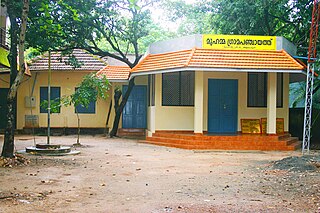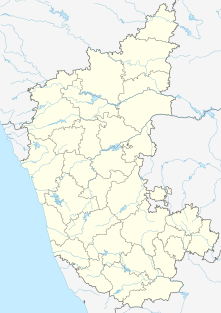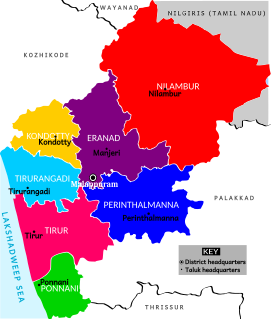Related Research Articles

Nadia district is a district in the state of West Bengal, India. It borders Bangladesh to the east, North 24 Parganas and Hooghly districts to the south, Purba Bardhaman to the west, and Murshidabad to the north.
Gram Panchayat is a basic village governing institute in Indian villages. It is a democratic structure at the grass-roots level in India. It is a political institute. It acts as cabinet of the village. The gram-Sabha work as the general body of Gram Panchayat. The members of the Gram panchayat are elected by the Gram Sabha.

South 24 Parganas or sometimes South Twenty Four Parganas is a district in the Indian state of West Bengal, headquartered in Alipore. It is the largest district of West Bengal by area and second largest by population. It is the sixth most populous district in India. On one side is the urban fringe of Kolkata and on the other, the remote riverine villages in the Sundarbans.

Tiruchirappalli District is one of the 38 districts, located along the Kaveri River, in Tamil Nadu, India. The headquarters of the district is the city of Tiruchirappalli, also known as Trichy.

Shamshabad is a town which serves as the headquarters of Ranga Reddy district of the Indian state of Telangana. It is located in Shamshabad mandal of Rajendranagar revenue division. The international airport of Hyderabad is located here.
A sarpanch or gram pradhan or mukhiya is a decision-maker, elected by the village-level constitutional body of local self-government called the Gram Sabha in India. The sarpanch, together with other elected panchayat members, constitute the gram panchayat. The sarpanch is the focal point of contact between government officers and the village community and retains power for five years.
Panchayat samiti is a rural local government (panchayat) body at the intermediate tehsil (taluka/mandal) level in India. It works for the villages of the tehsil that together are called a development block. It has been said to be the "panchayat of panchayats".

Council of five officials is the system of local self-government of villages in rural India as opposed to urban and suburban municipalities.
A Nagar Panchayat or Notified Area Council (NAC) in India is a settlement in transition from rural to urban and therefore a form of an urban political unit comparable to a municipality. An urban centre with more than 11,000 and less than 25,000 inhabitants is classified as a Nagar Panchayat.
Vadakkancheri-I is a village in Palakkad district in the state of Kerala, India. It is a part of the Vadakkancheri gram panchayat along with Vadakkancheri-II.

RannaBelagali is a Pattan Panchayat Town in the southern state of Karnataka, India. It is located in the Mudhol taluka of Bagalkot district in Karnataka
A tehsil is an administrative division in some countries of the Indian subcontinent that is usually translated to "township". It is a subdistrict of the area within a district including the designated city, town, hamlet, or other populated place that serves as its administrative centre, with possible additional towns, and usually a number of villages. The terms in India have replaced earlier geographical terms, such as pergunnah and thana.
Local government in India refers to governmental jurisdictions below the level of the state. India is a federal republic with three spheres of government: central, state and local. The 73rd and 74th constitutional amendments give recognition and protection to local governments and in addition each state has its own local government legislation. Since 1992, local government in India takes place in two very distinct forms. Urban localities, covered in the 74th amendment to the Constitution, have Nagar Palika but derive their powers from the individual state governments, while the powers of rural localities have been formalized under the panchayati raj system, under the 73rd amendment to the Constitution. For the history of traditional local government in India and South Asia, see panchayati raj.

Perinthalmanna Taluk, formerly known as Valluvanad Taluk, is a taluk in Malappuram district in the south Indian state of Kerala. The town of Perinthalmanna is the headquarters of the taluk.
Aldhal is a village in Belgaum district in the southern state of Karnataka, India. Administratively, it is part of the Naganur K D gram panchayat in Hukeri Taluka.
Naganur (K.D.) is a panchayat village in Belgaum district of Karnataka, India.
The Zila Panchayat or District Council or Mandal Parishad or District Panchayat , is the third tier of the Panchayati Raj system. Zila Parishad is an elected body. Block Pramukh of Block Panchayat are also represented in Zila Parishad. The members of the State Legislature and the members of the Parliament of India are members of the Zila Parishad.
Vadakkancheri may refer to

The Panchayat raj (panchayat "village council", raj "rule") is a political system, originating from the Indian subcontinent, found mainly in India, Pakistan, Bangladesh, Sri Lanka, and Nepal. It is the oldest system of local government in the Indian subcontinent, and historical mentions date to the 250 CE period. The word raj means "rule" and panchayat means "assembly" (ayat) of five (panch). Traditionally panchayats consisted of wise and respected elders chosen and accepted by the local community. However, there were varying forms of such assemblies. Traditionally, these assemblies settled disputes between individuals and between villages.
References
- ↑ "Reports of National Panchayat Directory". Ministry of Panchayati Raj. Retrieved 2 January 2014.
| | This article related to a location in Palakkad district, Kerala, India is a stub. You can help Wikipedia by expanding it. |